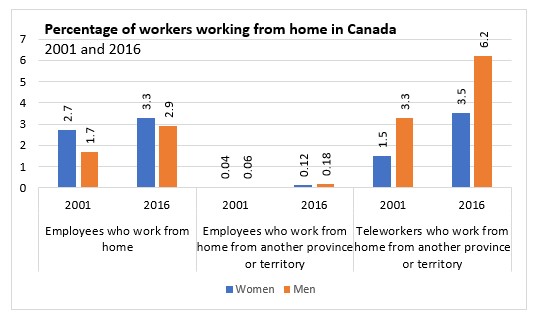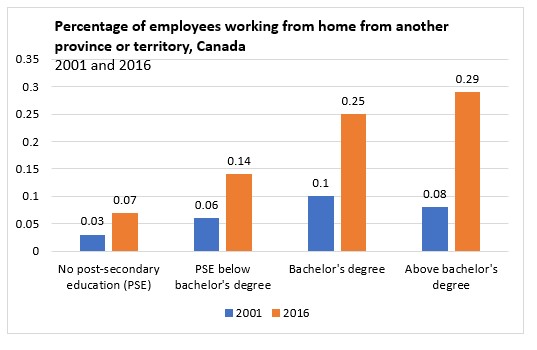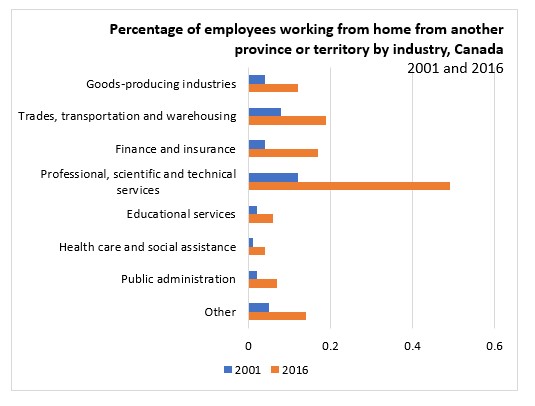The Economics and Statistics Division maintains archives of previous publications for accountability purposes, but makes no updates to keep these documents current with the latest data revisions from Statistics Canada. As a result, information in older documents may not be accurate. Please exercise caution when referring to older documents. For the latest information and historical data, please contact the individual listed to the right.
<--- Return to Archive
For additional information relating to this article, please contact:
February 23, 2022WORKING FROM HOME FOR AN EMPLOYER LOCATED IN ANOTHER PROVINCE OR TERRITORY Statistics Canada recently published an article focusing on the group of teleworkers who work for an employer located in another province or territory.
Using the Canadian Survey on Business Conditions (CSBC: fourth quarter of 2021) and integrated data from Statistics Canada’s Longitudinal Worker File (LWF) and the 2001 and 2016 Censuses of Population, the article assesses the amount of people who worked remotely, the groups that were more likely to telecommute, their compensation compared to that of other teleworkers, and the number of teleworkers that are likely to work remotely in the future.
While CSBC measures the number of employees that are expected to telework exclusively in the near future for a business located in another province or territory, the LWF and Census data measure the number of employees who worked from home for an employer located in another province or territory in 2001 and 2016. The analysis in the article exclude employees living in Ottawa-Gatineau as many of these employees work for the federal public administration in a province other than their province of residence.
Looking at employees aged 20 and over who were not students and had only one paid job in 2016, 12,600 (0.15%) worked from home for an employer located in another province or territory. This was up from roughly 3,500 workers in 2001. In 2016, 0.18% of men worked from home from another province or territory compared with 0.12% of women employees.

In 2016, interprovincial teleworkers represented only 4.8% of all teleworkers considered in this study. As such, 95.2% of employees working from home in 2016 worked for an employer located within their own province or territory of residence.
On average, workers working from another province or territory earned $101,300 in 2016 compared with $66,900 for other teleworkers. Statistics Canada noted that at least 80% of this earnings gap remains after controlling for broad occupations, indicating that differences in the types of occupations held are not the main factor behind these pay differences.
Among various education levels, workers holding post-bachelor’s degree diplomas (0.29%) were about four times more likely to work from home for an employer in another province than those with no postsecondary education (0.07%).

In 2016, employees in professional, scientific and technical services were about four times more likely to work from home from another province or territory (0.49%) than employees in goods-producing industries (0.12%). About 0.30% of employees in natural and applied sciences, arts, culture, recreation and sports and managers worked at home from another province or territory, more than twice the rate of 0.12% observed for employees in business, finance and administrative occupations.

Non-unionized employees in the commercial sector which excludes public administration, educational services as well as health care and social assistance were more likely (0.22%) than unionized workers (0.01%) to work from home for a business located in another province or territory.
According to the recent CSBC survey responses collected from employers during the fourth quarter of 2021, Canadian businesses expect about 113,000 (0.85% of workforce) of their employees to telework exclusively from another province or territory over the next three months. Employers in information and cultural industries expected almost 5% of their workforce to telework exclusively from another province or territory over the next three months, roughly twice the rates expected in wholesale trade (2.0%), finance and insurance (2.2%), professional, scientific and technical services (2.3%), as well as administrative and support, waste management and remediation services (2.6%).
While the findings of study highlight that Canadian business are moving towards more flexible work arrangements following the COVID-19 pandemic, teleworking from another province or territory is still available to a narrow segment of the workforce.
Future studies could investigate questions such as: how many employees work from home for an employer located abroad or for an employer located far within their own province?; are employees working from home for an employer located abroad concentrated in specific occupations?; and among employees expected to combine work from home and on-site work in the near future, what percentage are expected to work most of their hours from home?
Source: Statistics Canada. Working from home for an employer located in another province or territory
<--- Return to Archive